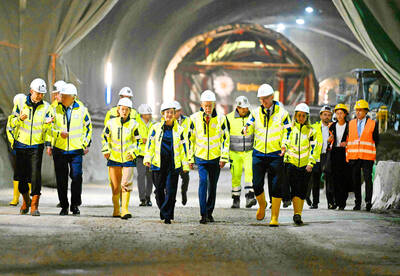Nanya Technology Corp (南亞科技), the nation's second-largest maker of memory chips used in computers, said yesterday quarterly losses had shrunk significantly over a price rebound, adding it would trim capital spending this year to help accelerate recovery from the industry’s severe, glut-driven slump.
Taoyuan-based Nanya posted its fifth consecutive quarterly losses at NT$7.3 billion (US$240 million) for the quarter ending on June 30, contracting 17 percent from NT$8.78 billion in the first quarter, a company statement said. The chipmaker posted losses of NT$2.83 billion a year ago.
“The improvement is mostly because of better chip prices,” said Pai Pei-lin (白培霖), a vice president at Nanya.
Contract prices for dynamic random access memory (DRAM) chips rose at a 20 percent quarterly pace in the April to last month period, Pai said.
Looking forward, Pai said net losses should narrow next quarter on the back of stabilizing DRAM prices, but the recovery may not be strong enough to bring Nanya back to profit any time soon.
“After a fast price rebound in the second quarter, we are feeling pressure from customers to further increase DRAM prices in August,” Pai said.
Demand is softening as rising inflation around the globe could significantly weaken consumers’ willingness to buy PCs and consumer electronics in the second half of the year, Pai said.
This was already reflected in the slower-than-expected demand during the back-to-school shopping season, he said.
Despite the narrowing losses, Rick Hsu (徐稦成), a senior research analyst at Nomura Securities Co’s Taipei branch, said: “we are still bearish about DRAM companies. The trough is not over yet as demand is still sluggish.”
“We don’t even know whether any DRAM companies will return to profit in the last quarter,” Hsu said.
Three months ago, some DRAM companies had expected the more than one-year-long series of quarterly losses would end in the next quarter, he said.
Partly because of slowing demand, Nanya intends to cut by 33 percent its capital spending this year, from NT$30 billion to NT$20 billion, Pai said.
“We plan to slow down our capacity expansion at FAB 3 [Nanya’s first 12-inch plant],” Pai said.
Coupled with the closure of an old factory, Nanya said the production growth rate should be 50 percent annually for this year, lower than the initial 65 percent estimate.
Inotera Memories Inc (華亞科技), a memory joint venture between Nanya and Germany’s Qimonda AG, posted net losses at NT$3.27 billion yesterday for the second quarter from losses of NT$4.18 billion in the first quarter, a company statement said.
Inotera had reported NT$273 million in earnings in the second quarter of last year.
Inotera would also cut capital spending for the second time this year to NT$23 billion, down 23 percent from NT$30 billion.
As a result of a better-than-expected technology upgrade and improving operation efficiency, however, Inotera’s output this year would grow by more than 60 percent from last year, faster than the initial plan for a 50 percent increase, company president Charles Kau (高啟全) said.
“That means a significant cost reduction,” Kau said. Fixed cost will be 30 percent lower, he said.

CHIP RACE: Three years of overbroad export controls drove foreign competitors to pursue their own AI chips, and ‘cost US taxpayers billions of dollars,’ Nvidia said China has figured out the US strategy for allowing it to buy Nvidia Corp’s H200s and is rejecting the artificial intelligence (AI) chip in favor of domestically developed semiconductors, White House AI adviser David Sacks said, citing news reports. US President Donald Trump on Monday said that he would allow shipments of Nvidia’s H200 chips to China, part of an administration effort backed by Sacks to challenge Chinese tech champions such as Huawei Technologies Co (華為) by bringing US competition to their home market. On Friday, Sacks signaled that he was uncertain about whether that approach would work. “They’re rejecting our chips,” Sacks

It is challenging to build infrastructure in much of Europe. Constrained budgets and polarized politics tend to undermine long-term projects, forcing officials to react to emergencies rather than plan for the future. Not in Austria. Today, the country is to officially open its Koralmbahn tunnel, the 5.9 billion euro (US$6.9 billion) centerpiece of a groundbreaking new railway that will eventually run from Poland’s Baltic coast to the Adriatic Sea, transforming travel within Austria and positioning the Alpine nation at the forefront of logistics in Europe. “It is Austria’s biggest socio-economic experiment in over a century,” said Eric Kirschner, an economist at Graz-based Joanneum

BUBBLE? Only a handful of companies are seeing rapid revenue growth and higher valuations, and it is not enough to call the AI trend a transformation, an analyst said Artificial intelligence (AI) is entering a more challenging phase next year as companies move beyond experimentation and begin demanding clear financial returns from a technology that has delivered big gains to only a small group of early adopters, PricewaterhouseCoopers (PwC) Taiwan said yesterday. Most organizations have been able to justify AI investments through cost recovery or modest efficiency gains, but few have achieved meaningful revenue growth or long-term competitive advantage, the consultancy said in its 2026 AI Business Predictions report. This growing performance gap is forcing executives to reconsider how AI is deployed across their organizations, it said. “Many companies

France is developing domestic production of electric vehicle (EV) batteries with an eye on industrial independence, but Asian experts are proving key in launching operations. In the Verkor factory outside the northern city of Dunkirk, which was inaugurated on Thursday, foreign specialists, notably from South Korea and Malaysia, are training the local staff. Verkor is the third battery gigafactory to open in northern France in a region that has become known as “Battery Valley.” At the Automotive Energy Supply Corp (AESC) factory near the city of Douai, where production has been under way for several months, Chinese engineers and technicians supervise French recruits. “They